Mokusho Zen House and the Zeisler Foundation present
MOKUSHO 25
A tribute to zen master Etienne Mokusho Zeisler
for the 25th anniversary of his death
2015.06.07 – 2016.06.07 – Zeisler Year
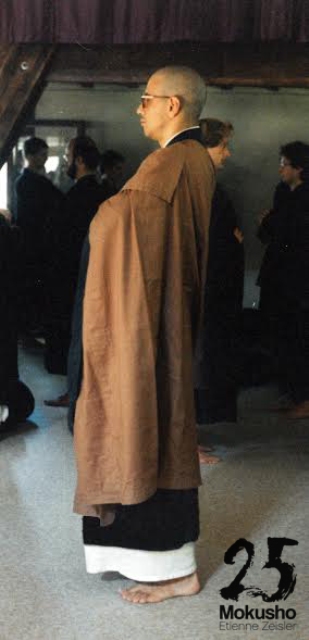
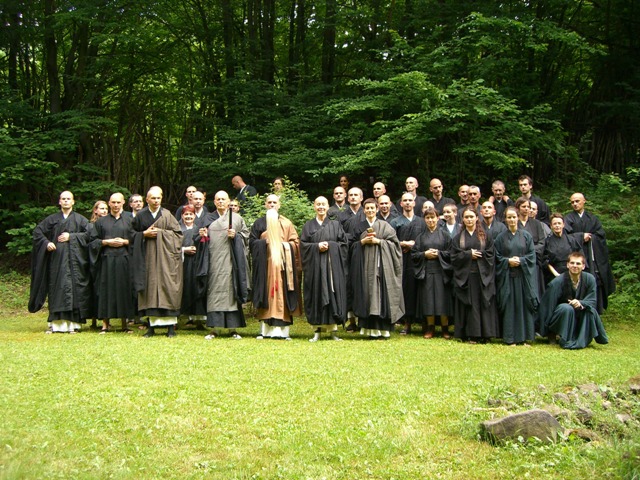
Etienne Mokusho Zeisler, treasure of the Great Sangha of master Deshimaru, died on the night of the 7th to the 8th of June, 1990, at the age of 44. His personality and his teaching left a deep trace at the bottom of the mind of all those who knew him. His teachings and his zen are particularly transmitted and cherished in the Mokusho Zen sangha, founded in Hungary and Romania, following his vows. At the occasion of this 25 anniversary year of his death, we invoke his memory by offering you this one year project and this site, dedicated to his living heritage.
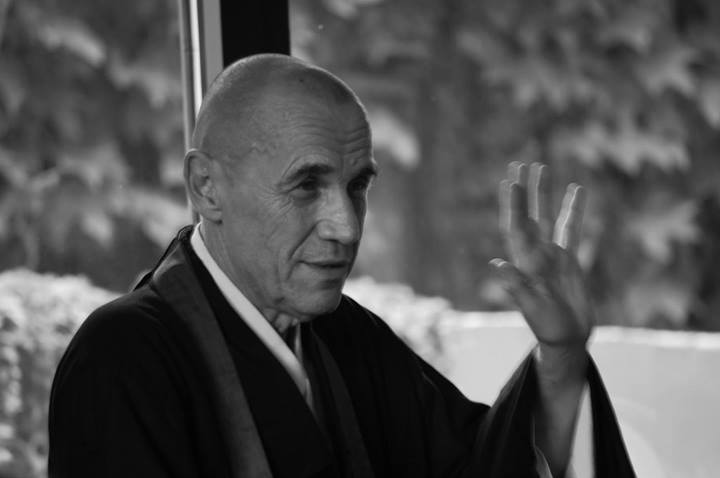
Etienne Mokusho Zeisler
The eighty-fourth generation Dharma-descendent of Shakjamuni Buddha in the lineage of Dogen, the second European and the first Hungarian patriarch.
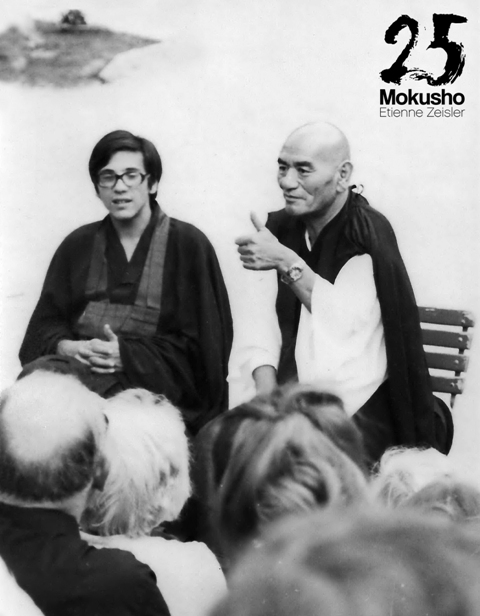
Mokusho Zeisler István was born in 1946, in Budapest, Hungary. He was three years old, when he moved to France with his parents. He grew up in Paris, where he studied law. In 1967 he met master Deshimaru, soon after his arrival to France. He was among the firsts who started practicing with him and he soon became his translator. He was one of the most remarkable figure of Deshimaru’s sangha; one of Deshimaru’s two main disciples.
In 1984, he received Dharma-transmission from Renpo Niwa Zenji, the abbot of Eiheiji along with Kosen Thibaut and Yuno Rech. From the death of the patriarch in 1982, until 1990, his charismatic personality, extraordinary energy and deep vision ensured the unity of the Deshimaru sangha.
 In 1990 he returned to Budapest to scatter the ashes of his father in the Danube, who has passed away two months earlier. He drove back from Budapest to Paris, where he passed away thirteen days later on the 8th of June, 1990.
In 1990 he returned to Budapest to scatter the ashes of his father in the Danube, who has passed away two months earlier. He drove back from Budapest to Paris, where he passed away thirteen days later on the 8th of June, 1990.
He wanted to return to his native country, to establish a dojo; a place to practice the Way, to bring the kesa; Buddha’s robe and the practice of zazen. His early death didn’t allow him to realize his plan, but he sent his first desciple, monk Myoken (Yvon Bec) to realize his vow. Myoken founded several temples in Hungary and Romania, as well as in neigboring countries and the Zeisler Foundation and the Mokusho Zen House, wearing the name of its spiritual founder.
 The purest practice in zen is called zazen, shikantaza, just sitting. It is also known as mokusho zen or silent illumination zen. Mokusho zen is considered as the highest, without any goal to achieve. Its wisdom cannot be fathomed. No categories can reach it. This is the name, that master Deshimaru gave to Etienne Zeisler, when he ordained him: Senku Mokusho, the Sage of Emptiness, Silent Illumination.
The purest practice in zen is called zazen, shikantaza, just sitting. It is also known as mokusho zen or silent illumination zen. Mokusho zen is considered as the highest, without any goal to achieve. Its wisdom cannot be fathomed. No categories can reach it. This is the name, that master Deshimaru gave to Etienne Zeisler, when he ordained him: Senku Mokusho, the Sage of Emptiness, Silent Illumination.
A ten day sesshin, (zenten) is held every June in the Hoboji zen temple in memory of master Zeisler: this is the Mokusho-sesshin. On the anniversary of his death, during the night of 7th till the 8th of June, traditionally a zazen night takes place, where we chant master Wanshi’s poem of Mokushoka, The song of silent illumination.
Commentary of Master Wanshi’s Mokushoka – From the book “Le chant de l’illumination silencieuse”, edited by the Zen International Association (AZI) “Mokushoka” (FR)
The poem of Barbara Kosen

Kyosaku puissant, très puissant
Amour Universel
Les cendres se répandent en silence.
Kyosaku poderoso, muy poderoso
Amor Universal
Las cenizas se esparcen en silencio
Powerful kyosaku, very powerful
Universal love
The ashes spread in silence
Erős kyosaku, nagyon erős
Egyetemes szeretet
A hamvak szétáradnak a csendben.

Barbara Kosen
Shorinji, Spain
Etienne Mokushô, 8 June 1990-8 June 2015

Etienne, Istvan, Light of Silence… He learned constraint silence across the border to flee his native Hungary, and began to speak in transmitting the Dharma… And since June 8, 1990 he is present to us in this silent light… Let me give a personal testimony, that the imprint of daily mark of humanity opens to the accomplished dimension of Man…
From my beginnings in the Zen sangha Deshimaru Rôshi, Etienne is one of the “great”… I have always had great admiration for him, and a deep friendship … silent … After the death of Sensei, violent turmoil has shaken our sangha. I put myself aside. I met Etienne, by chance … in a cafe Montparnasse to speak about the kesa … Then, following the death of his father, Francois Zeisler, whom I knew well, we remained close.
Little by little he shared with me his anxieties that he had about his health. Especially a phone call from Budapest, where he had gone to scatter the ashes of his father …
Then emergency hospitalization in Blois, and then very quickly he had to be hospitalized at Ambroise Pare in Boulogne. Rolland Garros had just started… It was a bit of a window into the life that goes on…
Service doctors let me announce to him the verdict of no return… Shock, despite its great lucidity… And especially great sadness of having to leave his sons… His condition deteriorated rapidly. We were a few to take turn near him. On the night of 7 to 8, Yvon Bec went around 23h. I stayed. At 2:05, his breath went out. The nurses asked me out for a moment they rendered homage to the dead body of their patient. Attitude of great nobility. I came back to him. Yvon returned about 5pm, to face the news and Guy Mercier, bringing his morning meal, now offering to the Buddha he became… This simple gesture, full of love, marked me a lot…
Since 1993 I have found back the Christian way that had guided me till the beginning of my adult life. Zen was my foster father and my mother for many years … and my zafu and practice companions are my brothers forever…
The great passage of Etienne was a great teaching. Passage from life to death, from death to Life …
Thank you Etienne Mokushô, forever…
Evelyne Holzapfel
Shô Getsu Fukusen
The answer is silent, your silence will be heard
The active passivity of a silent answer, living posture
Zen was influenced by the Japanese refinement, the Japanese delicacy. Sensei used to say:
“My Zen and the one from my Master Sawaki Kōdō were influenced by Nembutsu, and the Zen that
I have introduced in Europe will be influenced by Christianism”
(Mokusho Zeisler)
“Yes, he used to be strict, demanding, but not only… quite often Sensei would simply answer “, “As you like” pointed out Etienne Mokusho Zeisler to me the last time, in 1988 in Paris, that I had the opportunity to meet him.
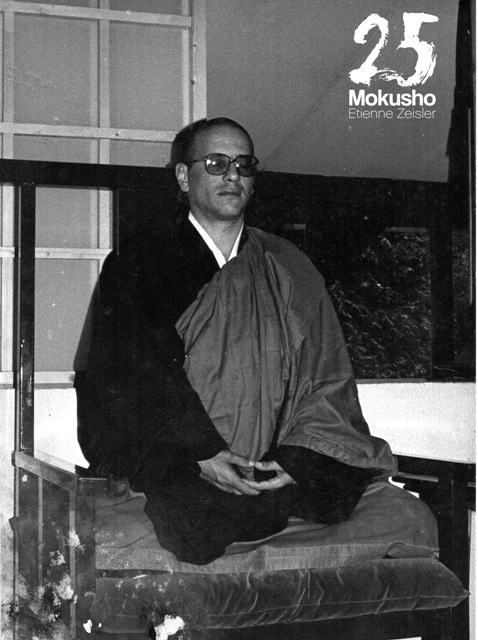
Apostle, hōsshi of the Lotus Sutra, he will forever occupy the Tathāgata’s Chair, he will inhabit his Abode and wear his Cloth. Witness for whom nobody gives testimony, in the perfect style of the Bodhisattvas emerged from the earth, he moves comfortably in the field of impossibility. Ravished and understood, he announces the event, the reason, innen, of the appearance of Buddha in the world.
Of the Immensity of the fragment, of the extra-ordinary and factual appearance of Buddha in the world…
“To understand the appearance of Buddha in this world – in Christian terms, we could say: to understand that God incarnated himself – is like becoming intimate with the truth, becoming one with everything. It means to understand that this burming house – our body, our mind – is the original truth, is the son of man.” Calm naturalness, discreet and reserved, his is a poetry of the annunciation which, together with that annunciation, declares and clarifies the impossibility of the perfection of existence, of immortality; the impossibility to observe the Law with all its Rules and Precepts; the impossibility for the human mind to become as immense as the ideal of the Great Vehicle; to understand what nobody can understand; to save all the beings who are impossible to save; to believe what is impossible to believe, to practice what is impossible to practice….
To wonder, still, how to cut the sufferings that are impossible to cut, how to find the truth that nobody can find, how to hear the teaching that has never been preached.
He, whilst remaining far from both aspects of mastery, the one that relates to the sign question and the one that relates to the figure of the wise man capable of a totality, has the strength, the power to declare what cannot be proven, to declare the event of the human hope, and to accept, with open hands, the living question from the bottom of our mind, beyond our relations and ourselves. In other words to go back to the normal condition … Always healthy, always sober, always ordinary.
He doesn’t ask for negotiations, nor merits that would enable certain negotiations. He does not yield to the temptation of who would like to take Buddha hostage on account of acquired merits or the respect of a law, even the law of Buddha himself. For him Zen means to die quickly.
This makes Buddha appear in the world, a Buddha who has been here since the very beginning and who sees, with his eyes wide open, the eternity of a same place, of a same space before they get a name!
Silent answer to the living posture.
It is the essence of Religions, immeasurable, immense silence. To stay still in front of the lack of answers!
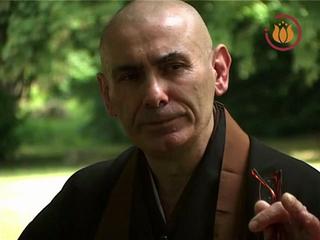
Fausto Taiten Guareschi
Fudenji Zen temple
A vibrant farewell

First days of June 1990. Etienne is hospitalized, I will visit the clinic. I get in a good mood, he seems happy with the visit. A few days ago began Roland Garros, on TV there is a match and we watch as we speak. I tell him that I will travel to the US with my son, Sebastian, who at that time was 5 years old, to visit my father to meet his grandson.
That evening we talked about everything and nothing, the conversation flows, follows its own course. Etienne told me zen, dojo, of this or that person, talking about Argentina, about my life before going to live in France, he told me about his recent trip to Budapest, we talked about my son, of his own, talked about tennis.
Almost no talk about his illness. I knew how bad it was, the sensitivity of their status, but it was obvious he did not want it to be a visit to a sick person. I was sad, but I held my sadness. I knew that my visit was a farewell, but it was a lively visit, a farewell full of life.
Just as I was leaving he said: I here in this bed and so close to Roland Garros, as I would be there.
It was the last time I saw him, I came to the United States on June 7 and the next day I received the news of his death. I lit incense and sat in zazen.
Sunday, 25 years later, I’m going to do the same, I joined all around the world to sit in zazen, light incense in your memory or simply remember in silence.
Fernando Schumerini
Like a meteor
His zen name was Mokushô, Silent Illumination. He shined with discretion, as he was a secret, subtle and deep being. When he translated Sensei, master Deshimaru, of whom he was the first disciple, he totally made way for him: we only heard the rhythm of the voice of the master, his intonations, nothing of Etienne would appear.

When alive master Deshimaru sent him to lead sesshin. When I started zazen in Paris, in 1970, he worked in the secretariat of master Deshimaru, which grouped together the zen Dojo of Paris and what would become the AZI, and his humour showed through each of his words.
Soon enough, after the death of master Deshimaru, while at that time we did not yet talk of sangha gathered around different masters, disciples followed him from zazen to zazen, from sesshin to sesshin. He was however blamed for it, what touched him pretty painfully.
I lived near his place and we would see each other privately often enough, we kept him company with Yvon, because he was alone, but in fact he really felt well only during zazen and especially during the sesshin, and, near the end of his life, the number of zazen during a day of retreat would only increase.
He commented marvellously the texts of the zen masters, the Tenzokyokun of master Dôgen, The song of the straw hut of master Sekito… His deep and soft voice harmonized well itself with the atmosphere of zazen.
He received the Dharma transmission (denpo) from Niwa Zenji, superior of the Eiheiji temple, along with two other disciples of master Deshimaru. These three were responsible of the sangha linked to the AZI and to the temple of La Gendronnière, as well as to the zen Dojo of Paris, of which Etienne became the president. He had taken back his old work, not anymore as secretary, but as president, and he spent all his days in the dojo of the Five-Diamonds street.
His death at the age of forty-four shocked us all. From the beginning of his illness to his death, very little time passed. He went like a meteor, in silence, leaving us his light that continues to shine eternally.

Katia Kôren Robel
Dojo zen du Châtelet
Une lettre de Ludger Tenryu et Laurence Tenbreul

À l‘occasion du 25° anniversaire du décès d’Etienne/Senku Mokusho Zeisler, nous avons étés profondément touchés de revoir ses photos publiées dans le Site Mokusho 25.
Elles rendent particulièrement vivants les souvenirs qui nous rattachent à lui :
Tout d’abord sa façon directe, sans artifices, sans annotations personnelles de traduire les Kusens de Sensei, révélant une honnêteté profonde et naturelle concernant son Maître et son enseignement, et une fidélité qui s’est concrétisée par la suite dans les fonctions qu’il a dû prendre après la mort de Maître Deshimaru.
Ayant reçu le Dempo de Niwa Zenji, il a pris cet héritage sans prétention, comme une mission, bien que lourde, à prendre naturellement en charge, rendant ainsi hommage au « continuer Zazen éternellement » de son précédent Maître.
Etienne qui était de nature secrète, même introvertie, très peu disposé à parler de ce qui le touchait de près, retrouvait, assis en Zazen, sa véritable place dans le monde. Les anciennes images qu’on a de lui en sont une bonne illustration.
En effet, au-delà des mots qu’il a utilisés dans ses Kusens, c’est surtout dans le silence de l’assise et non dans la parole que se révélaient la profondeur de sa nature et l’authenticité de sa foi.

Ludger Tenryu et Laurence Tenbreul
Mokushozan Jakkoji
Shogozan Zenkoji
Etienne was born on the 17th of February, 1946 in Budapest, to Katalin Taubner (daughter of a banker in Budapest and also Miss Budapest pre-war!!!) and Ferenc Zeisler (wool manufacturer). In 1948, they secretly fled Hungary to escape the Russian abuses. Their project was to join the United States but the “friend”, to whom they had entrusted the few possessions they destined to their flight, disappeared in the wild… They find themselves with nothing to Paris and compatriots gradually help to find work. His mother works in a garment factory and his father in the industrial knitting.

Etienne spoke French and Hungarian and decided at the age of 7 to translate his name from Istvan to Etienne. The whole family had the stateless status (status no longer exists). Etienne has made numerous attempts to obtain French citizenship, but only obtained it after the birth of Alexis in 1973! In 1968 and 69, when we met at Mr. Lambert’s yoga, we also followed the first lessons of Sensei, especially zazen Sunday in Gretz, the Theravada temple of Mr. Joly. This is where we received the Bodhisattva ordination. We went for the first time to Japan in 1970 with Sensei.
This photograph was taken in the dojo of Avenue du Maine at the day of the marriage of Etienne and Malika. Ferenc Zeisler, father of Etienne Zeisler is behind Master Deshimaru.
Malika Reigetsu Le Grand
The color of the kesa
Mokusho Zeisler translating Master Deshimaru’s teaching about the kesa*.

When I made my first kesa, I wanted to do it as traditional as possible. A friend found some nice old blankets. I cut the best parts out of it. In the Gendronnière there was a walnut-tree and I started to gather the nutshells. From the peels I made a kind of soup and started to impregnate the tissues. The tissues were not impressed and stayed almost there original white colour. I made some compromise and bought bottles of concentrated nut liquid. After hours and hours of work and a lot more bottles the tissues got a beautiful light brown colour.
I choose a green yarn and started to sew. The more it advanced the more I liked the combination and the more also increased the protest from the ancient nuns. Masters only wore this colour. I should dye it again but in a dark colour, which fits for all and especially for beginners.

I became in a moral dilemma and decided to subject me to the Salomon’s judgement of Etienne, who had already ordained me monk. He was godo of this sesshin and I went to the master room. I showed him the kesa and explained my embarrassment. Etienne smiled at me. ‘Yes’, he said, ‘you should respect the old nuns!’I got fear. Then he said: “Tell them you’re going to paint it after you’ve received it!” He gave me a big comprehensive smile and left me alone.
The kesa lasted only for 5 years. The old tissues and the long soaking process had made it vulnerable. I sewed a new kesa, a black one.

Paul Dokusan Loomans
European Zen Center, Amsterdam
* Audio sent by Alain Kaisen Krystaszek
To the memory of Etienne Mokusho Zeisler
He was known under his dharma name, and before anyone calls him master, a young monk arrived one day in my dojo to lead a sesshin, his first sesshin in Barcelona. That is the way I knew Etienne Mokusho Zeisler, and in this first retreat a spiritual unshakeable link is born, beyond any word, beyond titles, and beyond time. I felt an infinite gratitude and the silent zen manifested itself.

We saw each other in the sesshin, two or three times a year, in La Gendronnière, in Barcelona, Sevilla, or in the Basque country, sometimes in Paris. On my way the meeting with Etienne has been a decisive strong point. I felt accompanied from the first moment in a wise and warm way, exempted of any mystification. We could stay together the whole day almost without talking, however a clear communication was taken place without any need of pretending anything: nothing to explain. I found a true spiritual friend. Etienne was an example of simplicity in his manners as well as in his determination in what is fundamental. He was bearing no special interest in being a master, but after the death of Deshimaru he became his natural successor in the Dharma. In the dojo he was like a dragon entering his own house, his teaching appeared in a natural and deep way, without any trick, through his words and his silences.
His translations and commentaries of classical texts, which were the manifestation of his understanding and of his teaching approach, brought us fresh water, most precious. The song of the silent illumination of Wanshi and its silent zen, or the Tenzo Kyokun from Dogen – the teaching to the cook allied to the rigor in the daily life practice following the three attitudes, or “spirits” -, are true examples. We listened to the speech of the kindness, to the joy, or to the lack of prejudices, as the expression of the Way and of the ideal of our life.
He transmitted the importance and the rigor of the rules of Dogen, the necessity of preserving the dojo as the place of practice-realization of the awakening by always putting zazen before any other consideration.
He assumed in a complex moment the heritage of Deshimaru Roshi by being one of the first European teachers to speak by his own voice, and spread the seeds of the dharma with a total generosity.
Time is passing like an arrow, already 25 years from his death, but he continues by our side to illuminate the way. Would his example and his memory serve to make arise in us the thanks, the determination and the love, in order for us not to loose this precious moment, and not to forget this admirable ideal.
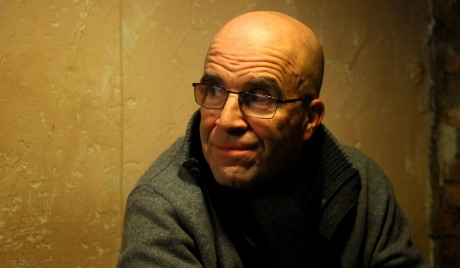
Pedro Taiho Secorún
Shingetsuji, Barcelona, April, 2015
In memory of my master Étienne Mokusho Zeister

I began Zen practice in a sesshin with Master Deshimaru in Barcelona. Later, to the sesshin of Seville, the Master had health problems and he sent in his place his Italian disciple Fausto Guareschi. He impressed me and I decided to follow him to the Gendronnière. It was summer of 1982, and a table tennis championship was held there. I love this game, so I got registered. Then they told me I had to play against Étienne, that everyone knew but I found him nowhere. Until touching my shoulder, he said, “Pedro, it is you! Do you want to play now? “. His presence impressed me, but not his skill in table tennis!
Later in Barcelona, during sesshin, being a pillar in a zazen in the evening, I was so moved, I felt so happy, everything in the light, as if it was my first Grand Amour, unconditional, irreversible. I followed him wherever I could, in France, Andalusia, etc. In the Gendronnière, summer of Tenzo Kyokun, I was ordained as a monk. I was proud to be his disciple and to listen his kusens in the dojo. For me it was like going to the actual University all of a sudden. Not understanding the French did not matter, his voice was warm and with tone. I only knew what was the first and last word, the rest remained there, somewhere inside. Where I had the opportunity to analyze his teachings with the translator for Spanish after zazen. It was Paco Villalba, expert in translation and master Dokusho Villalba today.
I have many stories, but here are two that reflect the immense quiet offered by Etienne and the relentless storm that unleashed to protect the Dharma, the zazen, atmosphere, silent breath.
The first is about Gendronnière. I was kyosaku and Etienne was the Godo. It was a quiet afternoon and two squirrels entered the dojo to play between all the bodies still in zazen. My heart went up and down with them, I was really uncomfortable until they are gone. Once gone, Etienne opened his eyes a little and gently calmed me completely.
The other story is during the sesshin of Girona. During zazen of the night, they lacked ten people. Étienne realized this and called the kyosaku. I approached, and he asked me to see what happens and go get them. I went there and I found them at the nearest village. There I had to announce to the monks that tomorrow he would give them the Rensaku. This direct form of “punishment”, I was very shocked. Etienne made use of the phenomena that occur during the sesshin to transmit Dharma. A great teacher, which seemed that there was not and I could find inside.
When Fernando called me to tell me he died, I wondered immediately “who will continue all this? Replacing this teaching?”. Today, 25 years have passed and I know that all this continues, teaching continues to express itself, and that is why I offer my deepest respect to Master Kosen Stéphane Thibaut, Master Kosen Barbara and Master Myoken Yvon Bec. Gassho.

Pere Shin Gyo Gasol
Terrassa 11 may 2015
A letter from Roland Yuno Rech
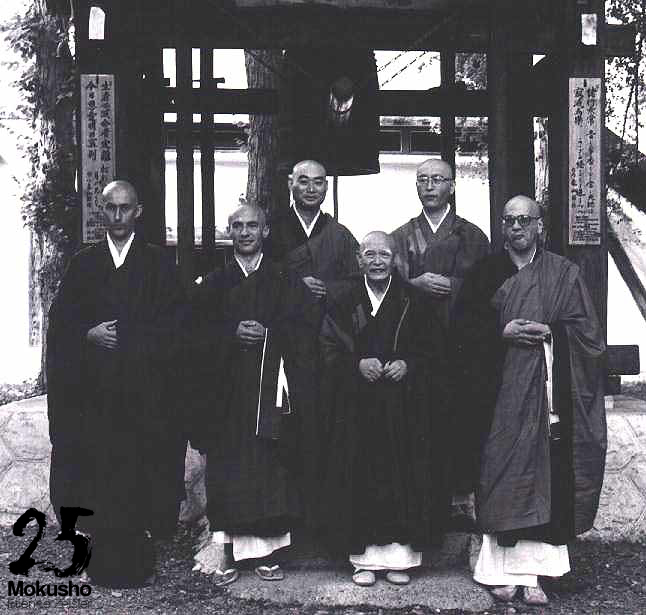
Etienne, who like Master Deshimaru did not have the time to transmit the shiho to his disciples, amply deserves this hommage and this posterity.
When I first met master Deshimaru, in september 1972 in Zinal, it was Etienne who faithfully translated him. One could feel a true communion I shin den shin between them. Etienne intuitively understood what Sensei wanted to say because he was not hindered by his own thoughts. Like his name suggests, Mokusho was very silent but also very attentive and very present. In summary, a true monk!
He had numerous disciples who 25 years after his death continue to practice with confidence, being still impregnated with his teachings. I had the joy to receive the shiho from Niwa Zenji at the same time as he and Stéphane Thibaut. Despite our very different personalities we share the same dharma. Thank you for preserving it and transmitting it.

Roland Yuno Rech
Temple Gyobutsuji
Etienne Mokusho Zeisler
When I arrived in Zen in 1969, the sangha of Master Deshimaru was still in its infancy and it only existed for two years. This sangha was then only a small group, whose main disciple was Mr Lambert, president of the International Yoga Institute of France.

Although this man was through his function in relation with the greatest masters of Indian yoga (such as the swami Shivanandha or the swami Satshitanandha), he will not be long, followed by some number of his pupils, to swear allegiance to Master Deshimaru as his main mentor.
Among the students of Mr Lambert, there were a couple of young and beautiful teenagers: Etienne and Malika. A tall brown man and a beautiful blond woman, calm, radiant and in love. They very soon embodied in our zen group as the ideal of happiness and balance. It is the first image I had of Etienne and Malika, whose names seem inseparable.
They both had a splendid posture of zazen and Etienne who spoke English correctly became naturally the appointed translator of Master Deshimaru. No need to say that for the beginner that I was, they both inspired a great attraction and a lot of interest.
I have learnt later to better know Etienne although I was not from the same social and cultural environment. I would even say more: there was an obvious socio-cultural antinomy in between us. In the seventies, middle-class persons and anarchists would not inevitably share the same table.Obviously life made us bow our spine without delay; life, but not only, because in Zen we learn to stand up without arrogance and to bow without shame. We then met later as monks. First timidly, then step by step, pushed by the mutual respect like two brothers loved by the same father.
Etienne was a very secret and hard to surround young man and would not reveal easily his feelings, even to those who pretended to be his pals or his disciples. This attitude gave even more value to the intense moments during which he revealed himself. Sometimes he opened himself to me revealing his heart or his pain whereas I did not expect it. I was then amazed by the confidence that he gave to me. He was inclined to the sharing and even to a great generosity. One should not forget that being my senior in Zen, I found myself even more touched. Here is the teaching of one evening where Etienne had invited us to share some food at his home. Not complicated, of the style pasta with tomatoes sauce and fried eggs. It was a long time before the death of Master Deshimaru and I was talking of Zen with stars in my eyes:
“Deshimaru was a Buddha, all the Japanese had the satori and the Zen was the most important thing in the world.” Suddenly, Etienne looked at me with the hard intention to communicate something to me (at that time I never had gone to Japan), and he suddenly told me: “In Japan, the Zen is a sect without any importance that interests no one and they are really asking themselves why, us the Frenchs, we are interested in it.” I have to confess that on the spot I was stoned by such a way to talk but I never forgot these words, it was a sign that he had spoken truly. We should practice without any illusion concerning Zen or Buddhism, even concerning the satori; only zazen without waiting for anything is fundamental. All the rest is of secondary importance. It is true that from this time and thanks to the work that Deshimaru did in Europe and elsewhere, the Zen has recovered its universal value acknowledged in the entire world. It influences and will influence still for a long time, as our master wanted, all our civilization. Even if the Japanese are not anymore interested consciously in Zen, they are however soaked in it in their life and in their behaviour.

Stephane Kosen Thibaut
Shobogenji
Yujo Nyusanji
Master Etienne Mokusho Zeisler

Etienne Mokusho Zeisler (1946-1990) is born in Hungary. He was three years old when his family came to live in Paris. He was one of the most ancient disciples of Master Deshimaru calling him Sensei, in the same way as we call Master Zeisler, Etienne. He was his first translator and had acquired a great intimacy with him, letting his mind and his speech to follow naturally the ones of his master. His name, Mokusho, Silent Illumination, was the mirror of himself, few words, a warm voice, rarely an explosion that would be even more terrible, few typical gestures, an inner and communicative presence: the big brother that everyone could wish. He commented at length, among others, the Tenzo Kyokun of Master Dogen, the everyday life teaching for all. In Zen, he said, everyone addresses himself to himself, like the old tenzo who is drying his mushrooms. Besides, rather wild, he liked very much to go hunting for them, a far away figure in the park of La Gendronnière.
Master Mokusho Zeisler received the dharma transmission in 1984 from Master Niwa Zenji, the Superior of the Eihei-ji temple in Japan. His death in June 1990 unconsciously grew a piece of mirror in us. In his last kusen on the Sanjushichi Bodaibunpo, he says: Please pass in front”, and he let us the place. The ones who knew him have had and still have a great love, intimate, internal, and an infinite gratitude for him. During his last radio interview, he answered the question: “Etienne Zeisler, tell us at the end, explain to us, what is a zen monk.” Etienne then answered: “A zen monk, well, it is a zen monk.” Inmo.
“We should know the price and the value of the dharma deep inside our mind, our decision, for our life and our death. So the bodhisattva who searches for the dharma does not find anything. He forgets everything and in that instant, all things are resolved. The entire existence becomes perfect, simple, light, for him and for the others.
Please pass in front. The true compassion can appear, the true universal love. Transform, change a little bit your mind. Only look inside yourself. Where is the hell, where is the paradise? You, who practice, do zazen, teach, who are godo, where are you going? Decide quickly, rapidly. It is the diligent effort. The pure, clear effort. It is the posture of zazen.”
(Etienne Mokusho Zeisler, L’Illumination Silencieuse, AZI)

Vincent Keisen Vuillemin
Zen Dojo Genf
The videos of the ceremonies
Hungary – Hoboji Zen temple
Italy
Fudenji Zen Temple
France
Zen Temple la Gendronnière
Kanshoji Zen Monastery
Dojo Zen Toulouse
Seine Zen Paris Dojo
Spain
Dojo de Barcelona
Shorinji Zen Temple
Argentina
Dojo Zen de La Plata
Switzerland
Dojo Zen de Geneve
Unedited texts of Master Zeisler
- Kusen of 14th, November 1987 – Dojo de Paris – “Sozan and Titanic” (FR/EN)
- Kusen of 15th, April 1987 – Enköping, Sweden – “Tosui’s strong practice” (EN)
Translations of edited texts of Master Zeisler
- Commentary of Master Dogen’s Ju undo shiki – Rules of the dojo “Ju undo Shiki” (EN)
- Spanish translation by Nicolas Nessi from Argentina of Master Zeisler’s commentary on Ju undo shiki – Rules of the dojo “Ju undo Shiki” (ES)
- Transmission of Zen “A zen átadása” (HU)
- Commentary of Master Wanshi’s Mokushoka – From the book “Le chant de l’illumination silencieuse”, edited by the Zen International Association (AZI) “Mokushoka” (FR)
- Kusen – 1989 – Campins – Montseny – Barcelona – Kusen de Etienne Zeisler (SP)
- Kusen – 1989 Abril 13-15 – Sesshin Jabugo (SP)
- Kusen – 1989 Marzo – Sesshin de primavera (SP)
- Spanish translation by Maria Teresa Avila of Master Zeisler’s commentary on Sanjushichi-bodaibunpo – The 37 wings of enlightenment “Sanjushichi-bodaibunpo” (ES)
- Mokusho Etienne Zeisler speaks about master Deshimaru’s ‘great idea’ ‘Grande Idee’;
Lightning in Empty Sky
During the 25th anniversary year, a commemorative album will be published, including quotations and photos to the tribute Zen master Etienne Mokusho Zeisler.
This album intends to illustrate master Zeisler’s teaching by short quotations which can also be used as koans or turning words in the practice. It will contain rare photos of him, as well as a few pictures of the Mokusho Zen House sangha, illustrating Zeisler’s living heritage in Eastern Europe. Several contemporary Zen masters will share their memories about Mokusho.
More details about the project will be available soon.


The most important teachings of Master Zeisler are nowadays to be found in the book “Le chant de l’illumination silencieuse”, which was edited by the Zen International Association (AZI) immediately after his death. Important articles, that he wrote for the bullettin of the AZI were translated in Hungarian and published by the Mokusho Zen Ház under the title: “Zen átadása” – (La transmission du zen).
We just finished the Hungarian translation and publication of the “Ju-undo-shiki – Rules of the dojo” commentary of Master Zeisler, which will be followed by the edited version of the Shanjushichi Bodaibunpo.
 But still many dispersed and unedited oral teachings exist, that we intend to regroup and publish on this site during the Zeisler year. It’s also why we ask to all of you, who could have texts or photos in your possession to participate in the project Mokusho25 by sending and rearranging them on this site.
But still many dispersed and unedited oral teachings exist, that we intend to regroup and publish on this site during the Zeisler year. It’s also why we ask to all of you, who could have texts or photos in your possession to participate in the project Mokusho25 by sending and rearranging them on this site.
Yvon Myoken Bec
Commemorative Celebrations of Etienne Mokusho Zeisler
Hungary
|
Hoboji Zen Temple 2015. June 5th-June 14th Mokusho sesshin led by Yvon Myoken Bec, in the presence of:
About Hoboji: http://www.mokushozen.hu/zazen/index.php/en/dojok/hoboji Sesshin information: http://mokusho25.org/index.php/events/mokusho-sesshin |
Romania
|
Mokushozen-ji Temple Bucharest 2015. June 6th-7th Zazen night and ceremony dedicated to Master Zeisler About Mokushozen-ji Temple Bucharest: http://mokushozen.ro/ |
 |
|---|
France
|
Temple zen de La Gendronnière 2015. June 7th, 11:00 Closing ceremony of a two day sesshin, dedicated to Master Zeisler, held by Laure Hosetsu Scemama About Gendronnière: http://www.zen-azi.org/en/node/242 |
 |
|---|
|
Dojo zen du Châtelet 2015. June 6th, 11:00 Ceremony dedicated to Master Zeisler, held by Katia Kôren Robel About Dojo zen du Châtelet: http://associationzensotoparis.fr/ |
 |
|---|
|
Dojo zen de Paris, Parizan Bukkokuzenji 2015. May 30th-31st A sesshin dedicated to the memory of Mokusho Zeisler will be held, lead by Raphael Doko Triet About Dojo zen de Paris: http://www.dojozenparis.com/ |
 |
|---|
|
Zen monastery Kanshoji 2015. June 7th, 11:00 Commemorative ceremony to Master Zeisler, held by Jean-Pierre Taiun Faure About Kanshoji: http://www.kanshoji.org/ |
 |
|---|
|
Ryumon Ji Monastery Commemorative ceremony to Master Zeisler, held by Olivier Reigen Wang-Genh About Ryumon Ji: http://www.meditation-zen.org/ |
 |
|---|
|
Zen Temple de Vannes, Kokaiji 2015. June 13th, 18:30 Commemorative ceremony to Master Zeisler, held by Pierre Dôkan Crépon About Kokai Ji: http://kokaiji.weebly.com/ |
 |
|---|
|
Zen temple Gyobutsuji 2015. June 6th-7th Commemorative ceremony will be led by Roland Yuno Rech, during the sesshin held in Pegomas About Gyobutsuji: http://zen-nice.org/ |
 |
|---|
|
Dojo Zen of Die 2015. June 7th, 11:00 Commemorative ceremony will be led by Luc Taimyo Boussard About Zen dojo Die: http://deuxversants.com/wp/?page_id=221/ |
 |
|---|
|
Dojo du Puy en Velay 2015. May 23-24-25 Commemorative ceremony will be led by Edouard Shinryu Bagracbski, during the three day sesshin á L’arche About Zen dojo du Puy en Velay: http://zenvq.eklablog.com/ |
 |
|---|
|
Dojo Zen de Dijon 2015. June 7th, 11:00 Commemorative ceremony will be led by Francoise Jomon Julien About Zen dojo de Dijon: http://zen-deshimaru-dijon.pagesperso-orange.fr/ |
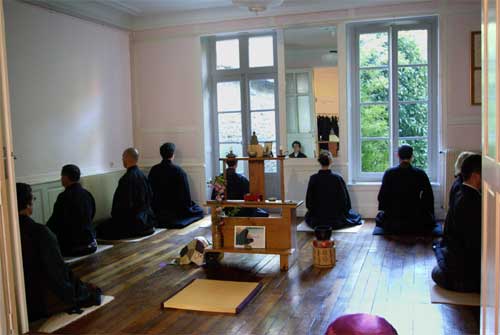 |
|---|
|
Dojo Zen de Toulouse 2015. June 7th, 11:00 Commemorative ceremony will be led by Bruno Kaiho Peslerbe About Zen dojo de Dijon: http://www.zentoulouse.fr/ |
 |
|---|
|
Dojo Zen de Montpellier 2015. June 7th, 9:00 A matinée of zazen dedicated to master Zeisler will be led by Stephane Kosen Thibaut About Dojo Zen de Montpellier: http://www.zen-montpellier.fr/ |
 |
|---|
|
Hoshoji Zen Temple 2015. June 7th, 11:00 A commemorative ceremony will be led by Alain Kaisen Krystaszek About Hoshoji: http://www.zenkaisen.fr/monastere-temple-zen/ |
 |
|---|
|
Dojo Zen d’Annonay 2015 June 6-7. The sesshin of Olonnes, led by Gérard Shinrei Pilet will be dedicated to Master Zeisler 2015. June 8th, 18:00 Ceremony dedicated to Master Zeisler, held by Gérard Shinrei Pilet About Dojo Zen d’Annonay: http://dojozenannonay.free.fr/ |
 |
|---|
|
Seine Zen Paris Dojo 2015. June 7th, 18:30 Ceremony dedicated to Master Zeisler, held by Philippe Rei Ryu Coupey About Seine Zen Paris Dojo: http://seinezen-paris.org/ |
 |
|---|
|
Denshinji Zen Temple, Blois 2015. June 5th-7th Sesshin and ceremony dedicated to Master Zeisler, led by Denis Kengan Rober About Denshinji Zen Temple: http://www.denshinji.fr/ |
 |
|---|
|
Dojo Zen de Lyon 2015. June 7th, 11:00 Ceremony dedicated to Master Zeisler, held by Loic Kosho Vuillemin About Dojo Zen de Lyon: http://www.dojozen-lyon.fr/ |
 |
|---|
|
Centre Zen de Lanau 2015. June 6, 7th, 11:00 Sesshin dedicated to Master Zeisler, held by Guy Mokuho Mercier au dojo de Lavallonais á Asquins/Vézelay About Centre Zen de Lanau: http://centrezenlanau.org/ |
 |
|---|
Switzerland
|
Dojo Zen de Genève 2015. June 6, 11:15 A commemorative ceremony to Master Zeisler About Dojo Zen de Genève: http://www.zen-deshimaru.ch/ |
 |
|---|
|
Muijoji Zen temple Zürich 2015. June 6th, 10:00 A commemorative ceremony to Master Zeisler will be led by Monika Eishuku Leibungut About Zen Dojo Zürich: http://www.zen.ch/ |
 |
|---|
Italy
|
Fudenji Zen temple 2015. June 7, 11:00 Commemorative ceremony to Master Zeisler, held by Fausto Taiten Guareschi About Fudenji Zen Temple: http://www.fudenji.it/ |
 |
|---|
Germany
|
Shogozan Zenkoji 2015. June 7th, 11:00 Commemorative ceremony to Master Zeisler, held by Ludger Tenryu Tenbreul About Shogozan Zenkoji: http://www.zen-vereinigung-berlin.de/ |
 |
|---|
|
Zen Dojo Fuku Gen 2015. June 4th-7th Sesshin dedicated to Master Zeisler, led by Anna Seisen Wassermeyer About Zen Dojo Fuku Gen: http://www.fukugen.de/ |
 |
|---|
Spain
|
Shorin-ji Templo Zen 2015. June 7th Commemorative ceremony to Master Zeisler, held by monk Jakudo About Shorin-ji: http://zenkan.com/shorinji-templo-zen/ |
 |
|---|
|
Soto Zen Monastery Luz Serena 2015. June 7th, 13:30 Commemorative ceremony to Master Zeisler, held by Francisco Dokushô Villalba About Monastery Luz Serena: http://sotozen.es/ |
 |
|---|
|
Centre Zen Barcelona – Shingetsuji 2015. June 7th, 11:00 Closing ceremony of a two day sesshin, dedicated to Master Zeisler held by Pedro Taiho Secorún Centre Zen Barcelona – Shingetsuji: http://www.zenbarcelona.org/ |
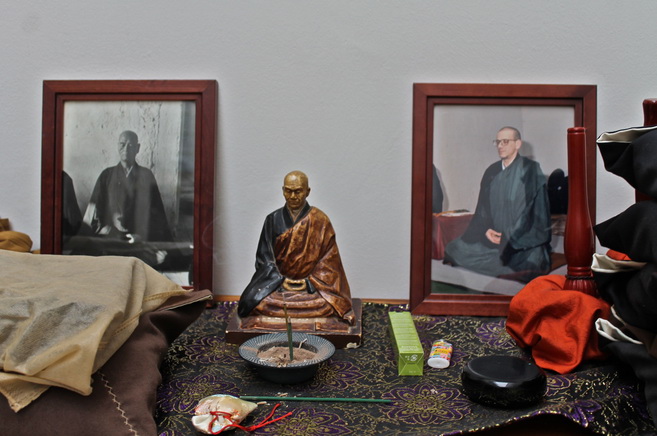 |
|---|
|
Dojo Zen Barcelona 2015 June 6-7 Sesshin lead by Pierre Soko Leroux Dojo Zen Barcelona: http://www.zen-barcelona.com/web/ |
 |
|---|
|
Dojo Zen Algerciras 2015 June 7 23:00 A ceremony lead by Agustin Utrera Souza Dojo Zen Algerciras: http://www.zen-deshimaru.com/en/dojos/algeciras-zen-dojo |
Netherlands
|
European Zen Center Amsterdam 2015 June 7. 11:00 Commemorative ceremony to Master Zeisler More Information: http://www.zen-deshimaru.nl/ |
 |
|---|
Sweden
|
Zen dojo of Uppsala 2015. June 6th Zazen day dedicated to Master Zeisler, led by Cecilia Waldenström About Zen dojo of Uppsala: http://uppsalazen.blogspot.hu/ |
 |
|---|
|
Zen Dojo Vastkusten in Vastra Frölunda 2015. June 7th, 11:00 Morning zazen and ceremony for master Zeisler, led by Paula Femenias |
Poland
|
Zazen International Poland 2015. June 7th, 11:00 Ceremony will be held in all the centers of Zazen International, established by Alain Keisan Krystaszek
About Zazen International Poland: http://www.zazen.pl/ |
Czech Republic
|
Zazen International Czech Republic 2015. June 7th, 11:00 Ceremony will be held in all the centers of Zazen International, established by Alain Keisan Krystaszek
About Zazen International Czech Republic: http://www.sotozen.cz/ |
 |
|---|
Slovakia
|
Zazen International Slovakia 2015. June 7th, 11:00 Ceremony will be held in all the centers of Zazen International, established by Alain Keisan Krystaszek
About Zazen International Slovakia: http://www.zazen.sk/ |
 |
|---|
Ukraine
|
Zazen International Ukraine 2015. June 7th, 11:00 Ceremony will be held in all the centers of Zazen International, established by Alain Keisan Krystaszek About Zazen International Ukraine: http://www.zen-kaisen.org.ua/ |
 |
|---|
Russia
|
Zazen International Russia 2015. June 7th, 11:00 Ceremony will be held in all the centers of Zazen International, established by Alain Keisan Krystaszek About Zazen International Russia: http://zen-kaisen.ru/ |
 |
|---|
United States of America
|
Kanzeon Zen Center Commemorative ceremony to Master Zeisler, held by Dennis Genpo Merzel Roshi during the retreat held in Coppenhagen More Information: http://bigmind.org/ |
 |
|---|
Mexico
|
Dojo Zen of San Miguel de Allende 2015. June 7th, 10:00 Dedicating a Zazen and ceremony to Master Etienne Mokusho Zeisler About Dojo Zen of San Miguel de Allende: http://zendojosanmiguel.wix.com/dojo-zen-san-miguel |
Cuba
|
La Habana Zen Dojo Commemorative ceremony to Master Zeisler More Information: http://www.zen-deshimaru.com/en/dojos/la-habana-zen-dojo |
Argentina
|
Shobogenji Zen Temple 2015. June 7th, 11:00 Matinee of zazen and ceremony dedicated to Master Zeisler, led by Ariadna Dosei Labbate About Shobogenji Zen Temple: http://www.shobogenji.com/ |
 |
|---|
|
Dojo Zen de La Plata 2015. June 7th, 11:30 Outdoor zazen in the Botanic Garden of Saavedra park and ceremony dedicated to Master Zeisler About Dojo Zen de La Plata: https://es-la.facebook.com/dojozen.laplata |
 |
|---|
|
Dojo Zen Buenos Aires 2015. June 7th, 11:00 Zazen and ceremony dedicated to Master Zeisler, led by Toshi Yamauchi About Zen Buenos Aires: http://www.zen-buenosaires.com.ar/ |
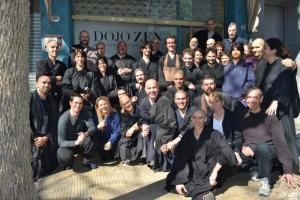 |
|---|
|
Dojo Zen de Bariloche 2015. June 7th, 11:00 Half day of zazen and ceremony dedicated to Master Zeisler About Zen Dojo de Bariloche: https://es-la.facebook.com/dojozen.bche |
 |
|---|
|
Dojo Zen de Rosario 2015. June 7th, 11:00 Half day of zazen and ceremony dedicated to Master Zeisler About Dojo Zen de Rosario: http://zazenrosario.blogspot.hu/ |
 |
|---|
|
Dojo Zen de Lujan 2015. June 7th, 11:00 Half day of zazen and ceremony dedicated to Master Zeisler About Dojo Zen de Lujan: https://es-es.facebook.com/zen.lujan |
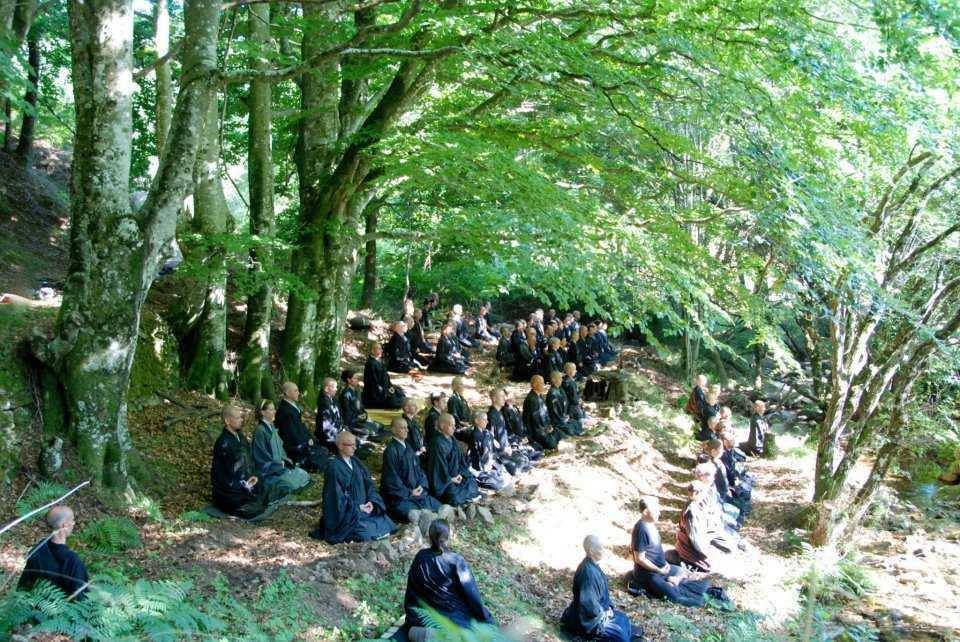 |
|---|
|
Dojo Zen Florida 2015. June 7th, 11:00 Ceremony dedicated to Master Zeisler About Dojo Zen de Lujan: https://es-es.facebook.com/zen.lujan |
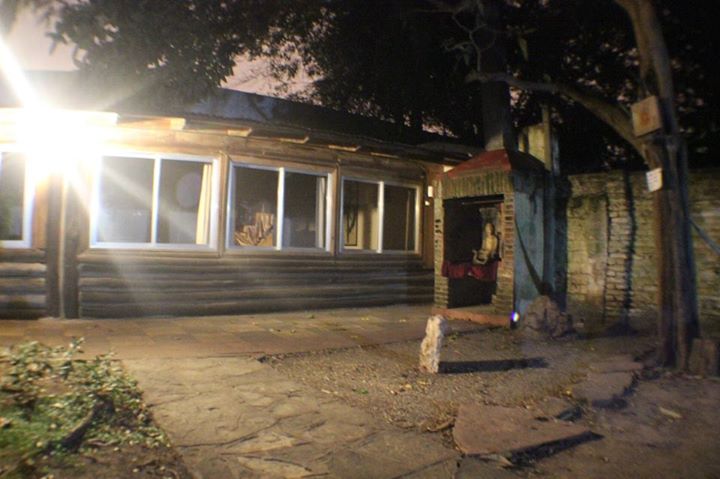 |
|---|
|
Grupo Zen du Saladillo 2015. June 7th, 10:00 Zazen and ceremony dedicated to Master Zeisler |
Ecuador
|
Mokusho Zen Ecuador 2015. June 7th, 11:00 Ceremony dedicated to Master Zeisler led by Caroline Nyoze Bacquet About Mokusho Zen Ecuador: https://www.facebook.com/mokushozenecuador |
 |
|---|
Chile
|
Sho Den Dojo Santaigo 2015. June 7th, 11:00 Zazen and ceremony dedicated to Master Zeisler About Sho Den Dojo: http://zenchile.blogspot.hu/ |
 |
|---|
Uruguay
|
Dojo Zen Montevideo 2015. June 7th, 11:00 Half day zazen and ceremony dedicated to Master Zeisler |
 |
|---|
Columbia
|
Fundacion para vivir el Zen André Reitai Lemort will be with us in spirit |
 |
|---|
Commemorative Celebrations in Russia
|
Zazen International Russia 2015. June 7th, 11:00 Ceremony will be held in all the centers of Zazen International, established by Alain Keisan Krystaszek About Zazen International Russia: http://zen-kaisen.ru/ |
 |
|---|
Mokusho Sesshin
5 to 14 June 2015
Hoboji Zen temple, Pilisszentlászó, Hungary
Program:
- 5 June, Friday, 17:00 – arrival to the Mokusho25 commemoration weekend
- 6 June, Saturday, 20:00 – zazen night (As an exception, this year the zazen night will take place one day earlier.)
- 7 June, Sunday, 11:00 – commemoration ceremony for Etienne Mokusho Zeisler
- 8 June, Monday, 6:00 – beginning of the Mokusho sesshin
- 13 June, Saturday, 8:00 – end of the Mokusho sesshin
- 13 June, Saturday, 20:00 – gardenparty for the 23rd anniversary of the Mokusho Zen House; Hungarian folk music and dance, Zen theater
- 14 June, Sunday, 8:00 – zazen and closing ceremony
Honorable guests of Mokusho sesshin 2015:
- Paul Ryuten Rosenblum roshi, Dharma Sangha Europe, Suzuki lineage
- Corinne Shared Joy Frottier sensei, Genjo An Sangha, Maezumi lineage
- Barbara Kosen, Zenkan Sangha, Deshimaru lineage
- Vincent Keisen Vuillemin, Ryu Kai Sangha, Deshimaru lineage
- Paul Dokusan Loomans, Kosen Sangha, Deshimaru lineage
- Marie Therese Zanshin Faur, La Gendronniére, Deshimaru lineage
- Anna Seisen Wassermeyer, Fukugen Sangha, Deshimaru lineage
